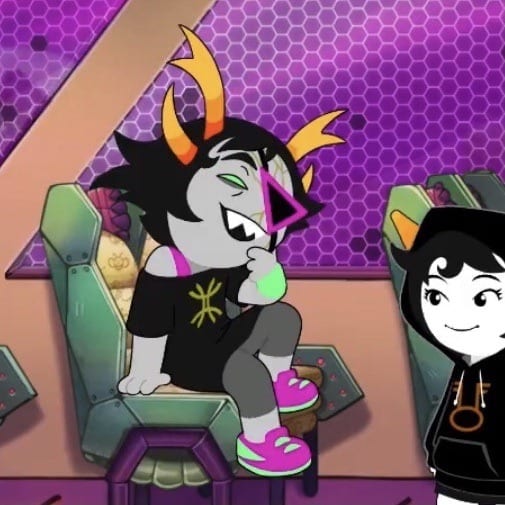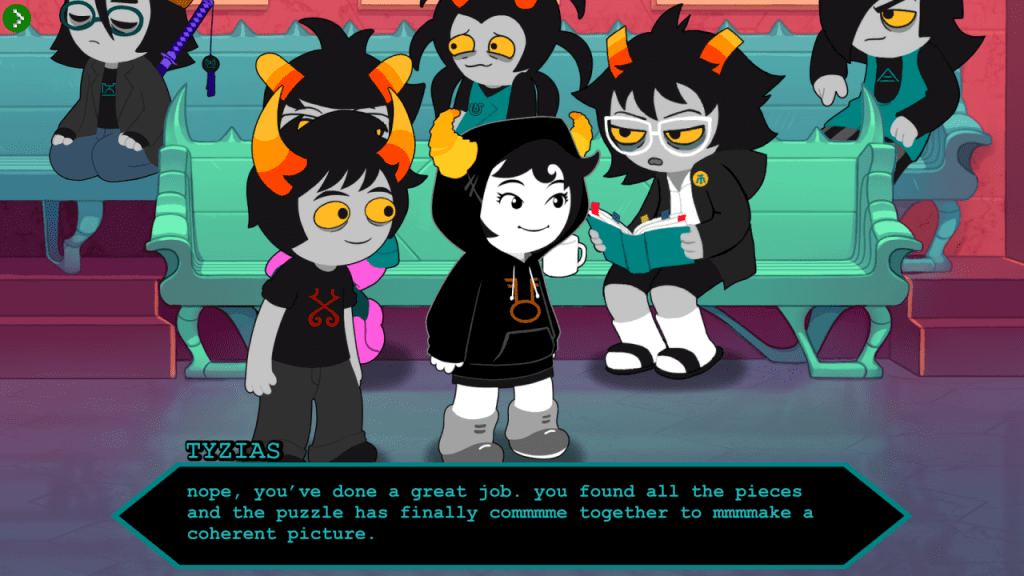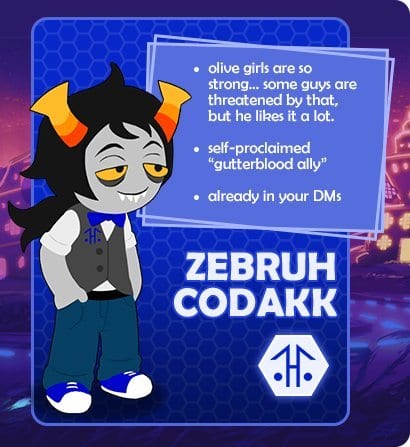*DISCLAIMER: THIS ARTICLE CONTAINS STORY SPOILERS FOR HIVESWAP ACTS 1 & 2*
If video games were a metaphorical cake, the characters would be the cherries on top. We grow attached to them, see ourselves in them, and may even aspire to be like them. Like most things, these casts usually fit into a set of archetypes: the optimistic protagonist, the nerd, the morally ambivalent antihero and, of course, the villain. Archetypes like these are important as they help players not only get an idea of where the story is going, but also develop those precious player-character bonds.
This is why I found Hiveswap (2020) to be particularly interesting.
Developed by WhatPumpkin games, founded by Homestuck creator Andrew Hussie, Hiveswap is a point-and-click adventure set in the same universe as the aforementioned, equally loved and detested webcomic. So far only two ‘Acts’ of the game have been released, but it’s already looking promising.
The game is a pleasant experience from start to finish with gorgeous visuals, a fun, catchy soundtrack, and genre-typical puzzles that really get you thinking. However, much like its divisive source material, Hiveswap’s most compelling aspect is its large cast of unusual characters and how all of them all terrible. Not terrible as in badly written, but terrible as in none of them are good people. They lie, they deceive, and they go out of their way to hurt others. I’m here to tell you why that’s a good thing.
What’s The Story?
You play as Joey Claire, an average 14-year-old whose home suddenly gets invaded by monsters. After exploring the household, literally dancing some creatures to death, and taking part in some point-and-click shenanigans, Joey ends up being transported to the planet of Alternia.
Within literal minutes of being stranded on this new world, she finds herself in contact with Xefros—our second playable character and the first of many aliens (the game’s official term is ‘trolls’), we’ll meet as the game goes on. Xefros also acts as a valuable exposition dump throughout the two Acts, introducing Joey to the ins-and-outs of Alternian culture and society. After meeting up outside the young troll’s house (or ‘hive’), the two head out to catch a train in hopes of meeting someone who can help Joey get back home.
The majority of the second Act takes place on this train, moving from the caboose to the conductor’s car, completing tasks and getting to know different trolls along the way.
Products of Society
As I said, Hiveswap’s cast is made up of some real unsavoury characters, but it’s important we understand why they might act the way they do.
The player will quickly learn from Xefros that this planet’s society is a rather brutal one. Each troll rests somewhere on a hemospectrum—a social hierarchy based on blood colour, with burgundy being the lowest class and fuchsia being the highest. This spectrum does not only determine a troll’s social standing, but also determines their future professions and general lifespan. As any oppressive system does, this makes some of the characters you meet a little disenchanted with their general existence and purpose.
Gold-blooded Cirava is a prime example. They have psionic abilities, a trait exclusive to their caste. While this does make them extremely powerful, it also dooms them to a future life as, essentially, a living battery for the planet’s ruler. In order to avoid this, Cirava gouged out their own eye to limit their abilities, making them a less desirable power source.
Though Cirava is one of the more laidback and friendly trolls Joey encounters, they’re definitely the most apathetic. Their traumatic experiences with the system have made them bitterly nonchalant, staying out of anything that doesn’t concern them, even if their knowledge and abilities could be a massive help.
Moral Ambiguity
In a similar vein, many of the characters who appear to be morally just usually aren’t and the third car of the train is full of trolls that fit this bill. From the seemingly adorable jade-blood Wanshi, who actively tries to get one of her friends killed, to Tagora, a charming teal-blood who will only be of aid if you pay him or give him important items; the key example is Tyzias, another teal-blooded troll who, like the rest of her caste, is destined to become a lawyer.
Tyzias is a major player in Act 2, as she is the one who helps Joey orchestrate an Ace Attorney–style court trial to figure out who stole an important book. She gives you hints, tells you who to speak to, and helps with the interrogation process.
There are three outcomes of this trial: Joey getting thrown off the train by the culprit, resulting in a game over, the false conviction and execution of uptight jade-blood Lynera, and the true solution—a mistrial, a scenario in which no one dies. Tyzias knows every outcome, including the actual guilty party, but she doesn’t tell you. Why? Because she used it all as an experiment for her own personal law theory.
As a teal-blood, Tyzias’s main interest is the Alternian law system, but unlike other teals she takes issue with it, disagreeing with the system’s inherent bias towards highbloods. As such, her experimental trial on the train mirrors that of Earth’s legal system, including the idea of innocent until proven guilty. While this is certainly a valiant pursuit, she still allows her experiment to result in undeserved death if certain decisions are made.
Similar to Cirava, Tyzias also allows her negative view of Alternia’s society dictate her choices, but unlike the Cirava, she doesn’t seem to care who gets hurt in her pursuits for justice.
While she does claim to have gripes with the system, she still lets it run its course—on the train at least. When Joey confronts Tyzias about her actions before moving onto the next car, she states that she has respect for the real perpetrator simply because they were able to sidestep the system. Not only that, she also states, in the event of Lynera’s death, that it was the better outcome simply because it stopped the jade-bloods from arguing.
This all paints a picture of a character struggling to balance her own selfish desires of defying the system with her need to refine it. A strangely poetic struggle for an alien wearing socks and sandals.
Straight-Up Scumbaggery
It’s not all so complicated though. Some of these characters are just genuinely horrid and there are a lot to choose from. The devilish Soleil twins, the blunt and cold Lanque, and Ardata, who attempts to kill Joey for no apparent reason. The most unanimously hated character is probably Zebruh, an indigo-blooded troll with a less-than-stellar reputation.
This bowtie wearing menace is the epitome of a desperate internet Nice Guy: someone who acts charming and progressive for the soul purpose of getting in someone’s pants. He frequently describes lowbloods, including our two protagonists, as “feisty” and “cute” only to start his own personal pity party if he’s rejected.
As an indigo, Zebruh is only a few steps down from being the highest of high society, meaning that his actions have little to no repercussions. He can aggressively flirt with and manipulate lowbloods as much as he wants, because standing up to a highblood is literally a death sentence. Indigoes are also implied to not only be socially powerful, but physically as well—often seeking professions in the military or as bodyguards—adding an extra layer of threat to his advances.
This would be bad enough on its own, but this guy stoops lower by claiming to be a ‘lowblood ally,’ supposedly a powerful voice who will use his status in society to make underappreciated voices heard. Of course, much like the subculture he’s based on, these claims of chivalry and ‘wokeness’ are all just for show in an attempt to lure vulnerable trolls in for the possibility of romance. But wait, it gets worse.
Prior to Act 2’s release, a dating sim-esque title called Friendsim was revealed, giving prospective players the opportunity to get to know these new trolls better. In Zebruh’s route, it is revealed that he has ‘guests’ that work at his hive, all of which are described to be malnourished and frightened of him. Some of these guests even bow in his presence, a gesture at which the narrator notes Zebruh appears ‘uncomfortable, but not too uncomfortable’ with.
Not only that, but all of these guests are lowbloods; the exact same demographic he claims to support and find attractive, which, in itself, has its own set of implications. These guests aren’t mentioned in Hiveswap, but his disturbingly persistent fetishizing behaviour is still there.
So, Why Does It Matter?
Obviously, this is only the tip of the character-based iceberg. Hiveswap’s cast features every kind of awful from the mundane to the murderous. But, despite their respective horridness, each character has their own pocket of fans. People who love them the same way they’d love a sweet sidekick or brave hero. Of course this isn’t anything too new and people, especially in online fandom spaces, have always loved villains—sometimes even more than the heroes. But I would argue that these characters aren’t villains, they’re all just side characters that happen to have some unpleasant traits or ominous motives.
Having gotten this far, you may now be asking yourself, “Why does this matter? Why are some weirdly evil characters in this somewhat obscure game important?” Well, to put it simply, it’s because the internet has a bit of a problem with morally grey characters. Though lots of people certainly love villains, when it comes to other characters that may not be 100% good, fandoms tend to go two ways: completely denouncing anyone who likes them or attempting to woobify the character to make them more appealing.
Notable examples from more mainstream fandoms would be Kylo Ren from the more recent Star Wars movies and Shiro from Voltron (2016-2018), two characters that have just as many people ready to wrap them up in a blanket as they do ready to stick their head on a pike.
Hiveswap, by making every character terrible in some way, avoids this pattern of fan behaviour because no matter who you get attached to, whether it’s the diminutive Boldir or the brutish Chahut, everyone will have some kind of secret or baggage. Just like real people, they are not perfect, they make mistakes, they’re not always as honest or as selfless as they’d like to be, and sometimes others get hurt in the process. Sure, they might not be the best, but they’re more than just how good they are. They are fascinating, three-dimensional characters.
Admitting your favourite character has done some bad things isn’t exactly wonderful, but when the characters are all so compelling, why should it matter?
Words by Ly Stewart
Support The Indiependent
We’re trying to raise £200 a month to help cover our operational costs. This includes our ‘Writer of the Month’ awards, where we recognise the amazing work produced by our contributor team. If you’ve enjoyed reading our site, we’d really appreciate it if you could donate to The Indiependent. Whether you can give £1 or £10, you’d be making a huge difference to our small team.




I absolutely love this article! It spotlights a problem that people have with morality ambiguous characters and how people reduce their character down in flanderization into their most desirable trait turning a three dimensional character into a paper cut out.